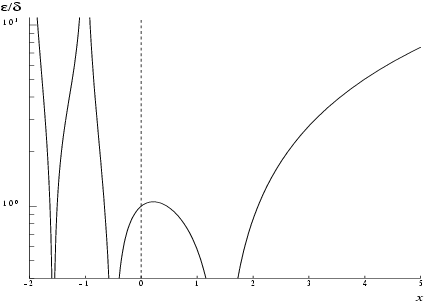NAG Library Routine Document
s14aaf
(gamma)
1
Purpose
s14aaf returns the value of the gamma function , via the function name.
2
Specification
Fortran Interface
| Real (Kind=nag_wp) | :: | s14aaf | | Integer, Intent (Inout) | :: |
ifail | | Real (Kind=nag_wp), Intent (In) | :: |
x |
|
C Header Interface
|
#include nagmk26.h
| double |
s14aaf_ (
const double *x,
Integer *ifail) |
|
3
Description
s14aaf evaluates an approximation to the gamma function
. The routine is based on the Chebyshev expansion:
and uses the property
. If
where
is integral and
then it follows that:
- for , ,
- for , ,
- for , .
There are four possible failures for this routine:
| (i) |
if is too large, there is a danger of overflow since could become too large to be represented in the machine; |
| (ii) |
if is too large and negative, there is a danger of underflow; |
| (iii) |
if is equal to a negative integer, would overflow since it has poles at such points; |
| (iv) |
if is too near zero, there is again the danger of overflow on some machines. For small , , and on some machines there exists a range of nonzero but small values of for which is larger than the greatest representable value. |
4
References
Abramowitz M and Stegun I A (1972) Handbook of Mathematical Functions (3rd Edition) Dover Publications
5
Arguments
- 1: – Real (Kind=nag_wp)Input
-
On entry: the argument of the function.
Constraint:
must not be zero or a negative integer.
- 2: – IntegerInput/Output
-
On entry:
ifail must be set to
,
. If you are unfamiliar with this argument you should refer to
Section 3.4 in How to Use the NAG Library and its Documentation for details.
For environments where it might be inappropriate to halt program execution when an error is detected, the value
is recommended. If the output of error messages is undesirable, then the value
is recommended. Otherwise, if you are not familiar with this argument, the recommended value is
.
When the value is used it is essential to test the value of ifail on exit.
On exit:
unless the routine detects an error or a warning has been flagged (see
Section 6).
6
Error Indicators and Warnings
If on entry
or
, explanatory error messages are output on the current error message unit (as defined by
x04aaf).
Errors or warnings detected by the routine:
-
The argument is too large. On soft failure the routine returns the approximate value of at the nearest valid argument.
-
The argument is too large and negative. On soft failure the routine returns zero.
-
The argument is too close to zero. On soft failure the routine returns the approximate value of at the nearest valid argument.
-
The argument is a negative integer, at which value is infinite. On soft failure the routine returns a large positive value.
An unexpected error has been triggered by this routine. Please
contact
NAG.
See
Section 3.9 in How to Use the NAG Library and its Documentation for further information.
Your licence key may have expired or may not have been installed correctly.
See
Section 3.8 in How to Use the NAG Library and its Documentation for further information.
Dynamic memory allocation failed.
See
Section 3.7 in How to Use the NAG Library and its Documentation for further information.
7
Accuracy
Let
and
be the relative errors in the argument and the result respectively. If
is somewhat larger than the
machine precision (i.e., is due to data errors etc.), then
and
are approximately related by:
(provided
is also greater than the representation error). Here
is the digamma function
.
Figure 1 shows the behaviour of the error amplification factor
.
If is of the same order as machine precision, then rounding errors could make slightly larger than the above relation predicts.
There is clearly a severe, but unavoidable, loss of accuracy for arguments close to the poles of at negative integers. However relative accuracy is preserved near the pole at right up to the point of failure arising from the danger of overflow.
Also accuracy will necessarily be lost as
becomes large since in this region
However since
increases rapidly with
, the routine must fail due to the danger of overflow before this loss of accuracy is too great. (For example, for
, the amplification factor
.)
8
Parallelism and Performance
s14aaf is not threaded in any implementation.
None.
10
Example
This example reads values of the argument from a file, evaluates the function at each value of and prints the results.
10.1
Program Text
Program Text (s14aafe.f90)
10.2
Program Data
Program Data (s14aafe.d)
10.3
Program Results
Program Results (s14aafe.r)

